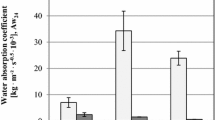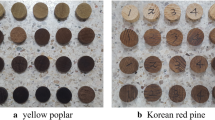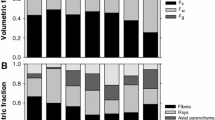Summary
The pressure membrane and pressure plate techniques were used to establish the moisture content-water potential (M-ψ) relationship of red pine (Pinus resinosa Ait.) sapwood in desorption above the fiber saturation point. The moisture content-water potential relationship is required for the development of a model of drying considering the gradient of water potential as the driving force of moisture in wood. This relationship was established at 18, 56 and 85 °C for radial desorption. The results obtained demonstrate that water potential ψ increases with temperature T at a given moisture content M. There is no significant variation of ∂ψ/∂T with temperature. Also, there is no plateau at intermediate moisture contents as was the case for the M-ψ relationship of aspen sapwood established in a previous work. The effective integral and differential pore size distributions inferred from the M-ψ relationship are also presented. The largest proportion of effective pore openings was found for a radius of 0.2 μm. This value can be related to the pit membrane openings of red pine.
Similar content being viewed by others
References
Babbitt, J. D. 1950. On the differential equations of diffusion. Can. J. Res. A-28: 449–474
Chahal, R. S. 1965. Effect of temperature and trapped air on matric suction. Soil Sci. 100(4): 262–266
Comstock, G. L.; Côté, W. A. 1968. Factors affecting permeability and pit aspiration in coniferous softwood. Wood Sci. Technol. 2: 279–291
Cloutier, A.; Fortin, Y. 1991a. Moisture content-water potential relationship of wood from saturated to dry conditions. Wood Sci. Technol. 23(2): 139–150
Cloutier, A.; Fortin, Y. 1991b. Unpublished data
Cloutier, A.; Fortin, Y.; Dhatt, G. 1992. A wood drying finite element model based on the water potential concept. Drying Technol. 10(5): 1151–1181
Cloutier, A.; Fortin, Y. 1993. A model of moisture movement in wood based on water potential and the determination of the effective water conductivity. Wood Sci. Technol. 27: 95–114
Cloutier, A.; Tremblay, C.; Fortin, Y. 1995. Effect of specimen structural orientation on the moisture content-water potential relationship of wood. Wood Sci. Technol. 29: 235–242
Comini, G.; Lewis, R. W. 1976. A numerical solution of two dimensional problems involving heat and mass transfer. Int. J. Heat Mass Transfer 19(12): 1387–1392
Fortin, Y. 1979. Moisture content-matric potential relationship and water flow properties of wood at high moisture contents. Ph.D. dissertation, The University of British Columbia, Vancouver. 187 p
Irudayaraj, J. K.; Haghighi, K.; Stroshine, R. L. 1990. Nonlinear finite element analysis of coupled heat and mass transfer problems with an application to timber drying. Drying Technology 8(4): 731–749
Kawai, S.; Nakato, K.; Sadoh, T. 1978. Moisture movement in wood below the fiber saturation point. Mokuzai Gakkaishi 24(5): 273–280
Kollmann, F. F. P.; Côté, W. A. 1968. Principles of wood science and technology. I Solid wood. Springer, Berlin Heidelberg New York, 231 p
Luikov, A. V. 1966. Heat and mass transfer in capillary-porous bodies. Pergamon Press, New York, 523 p
Panshin, A. J.; de Zeeuw, C. 1980. Textbook of Wood Technology. McGraw-Hill, New York, 722 p
Petty, J. A. 1970. Permeability and structure of the wood of Sitka spruce. Proc. R. Soc. Lond. B. 175: 149–166
Saha, R. S.; Tripathi, R. P. 1981. Effect of temperature on the soil-water content-suction relationship. Indian Soc. Soil Sci. 29(2): 143–147
Sebastian, L. P.; Côté, W. A.; Skaar, C. 1965. Relationship of gas phase permeability to ultra-structure of white spruce wood. For. Prod. J. 15: 394–404
Siau, J. F. 1983. Chemical potential as a driving force for nonisothermal moisture movement in wood. Wood Sci. Technol. 17(2): 101–105
Siau, J. F. 1984. Transport processes in wood. Springer-Verlag. New York. 245 p
Siau, J. F. 1992. Nonisothermal diffusion model based on irreversible thermodynamics. Wood Sci. Technol. 26(5): 325–328
Skaar, C. 1988. Wood-water relations. Springer-Verlag, New York, 283 p
Skaar, C.; Kuroda, N. 1985. Application of irreversible thermodynamics to moisture transport phenomena in wood. Proceedings of the North American Wood Drying Symposium, Mississippi Forest Products Utilization Laboratory: 152–158
Stamm, A. J.; Harris, E. E. 1953. Chemical processing of wood. New York, N.Y., Chem. Publ. Co. Inc., p. 113–138
Stanish, M. A. 1986. The roles of bound water chemical potential and gas phase diffusion in moisture transport through wood. Wood Sci. Technol. 20(1): 53–70
Thomas, H. R.; Lewis, R. W.; Morgan, K. 1980. An application of the finite element method to the drying of timber. Wood Fiber 11(4): 237–243
Author information
Authors and Affiliations
Additional information
This research project is currently supported by the Natural Sciences and Engineering Research Council of Canada under grant no. OGP0121954
Rights and permissions
About this article
Cite this article
Tremblay, C., Cloutier, A. & Fortin, Y. Moisture content-water potential relationship of red pine sapwood above the fiber saturation point and determination of the effective pore size distribution. Wood Sci.Technol. 30, 361–371 (1996). https://doi.org/10.1007/BF00223556
Received:
Issue Date:
DOI: https://doi.org/10.1007/BF00223556




